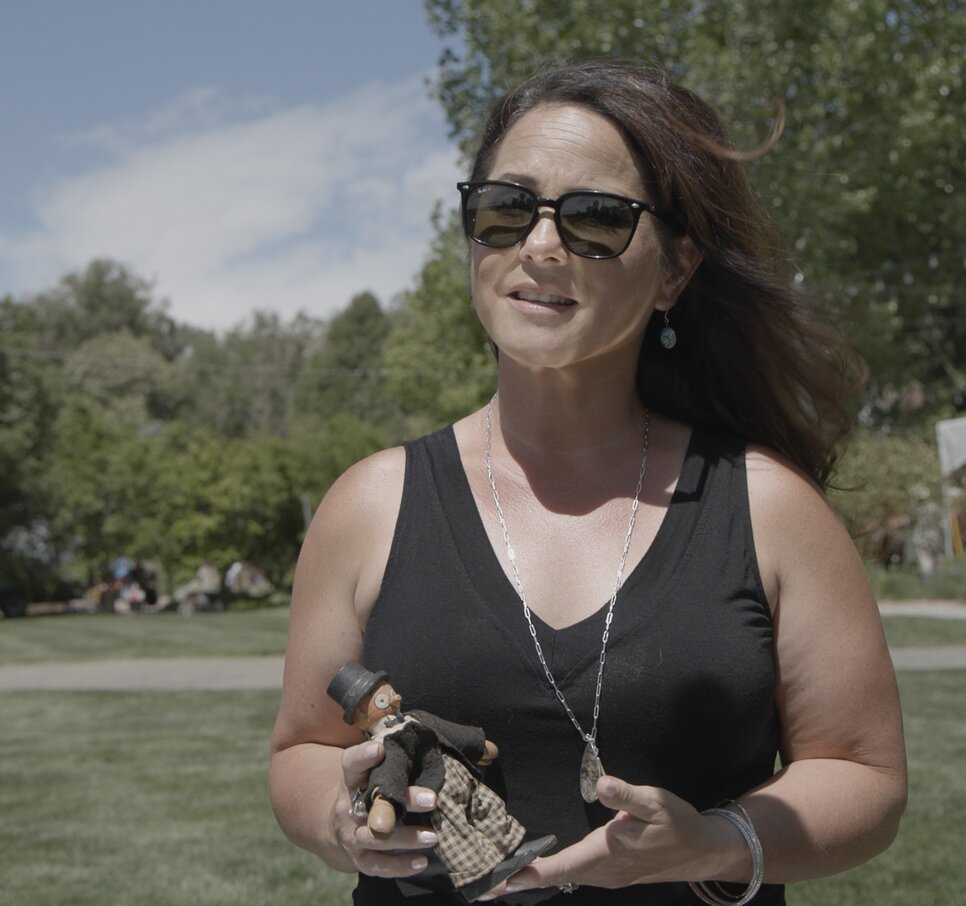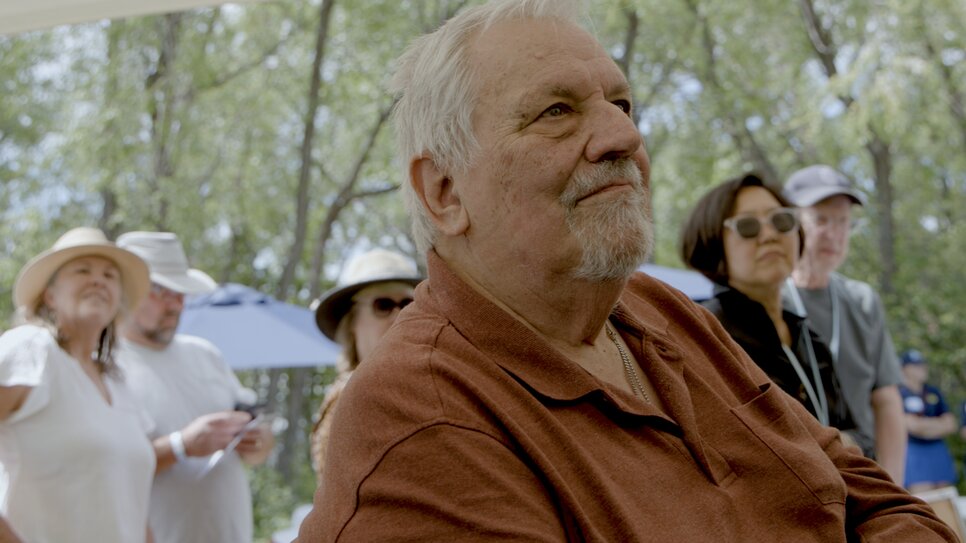Not trash but not quite treasure: Coloradans bring their wares to Antiques Roadshow
share

LITTLETON, Colo. — If there was ever a summer camp for adults, the Antiques Roadshow taping at Chatfield Farms at the end of May would be it.
For almost 12 hours, the people who won tickets — out of tens of thousands of applicants — focused on fun, sharing and learning the history of their treasured items. A lucky few made it to an on-air appraisal of their heirloom.
“Here’s the secret: Most of it's not worth much money,” said Marsha Bemko, the executive producer of Antiques Roadshow for 20 years and counting.
“Most of us don't own things that are worth a lot of money, but they are precious to us.”
Antiques Roadshow debuted on PBS in 1997 and is the network’s most-watched ongoing series. The concept? Regular folks bring in their antiques and meet with appraisers who assess their item’s true value and origin. Viewers learn history, often without even noticing.
Of the 2,500-3,000 guests that attend each Roadshow, about 150 are selected by producers to be on camera alongside an appraiser. About 30 end up in the broadcast.
“Nobody appearing on Antiques Roadshow is professional talent,” said Bemko. “They are people who own things like you and me, and they come to see our experts to learn more about them.”
The show was originally created in the UK in 1979 by the BBC, which still owns the trademark and licenses the show to other companies. Since 1997, GBH in Boston has been producing the show for PBS. Other countries like Sweden, Belgium and Germany also produce their own versions of Antiques Roadshow.
The Chatfield Farms recording marked the Roadshow’s fourth visit to Colorado — and its first time in Littleton. The last Colorado episode was shot in Denver in 2010.
“Back in the day, up until season 22 we did the shows in convention centers, and our whole set was built for just that,” said Bemko. “Many states have only one convention center. Some states have none.”
The move to outdoor locations, the biggest change the show has made to date, has enabled it to travel to smaller cities and towns such as Littleton. In addition to Littleton, season 29 will film in Las Vegas, Nevada; Bentonville, Arkansas; Urbandale, Iowa and Baltimore, Maryland.
All five locations are in production through May and June.
Littleton was the season’s most popular location. More than 20,000 people applied for tickets. The event hosted about 3,000 people and 110 community volunteers.
A total of 76 appraisers covering 23 specialties — including as paintings and drawings, books and manuscripts, jewelry, clocks and sports memorabilia — assessed the goods.
Many appraisers have been with the show for years and, perhaps surprisingly, don’t receive payment for their participation. They volunteer their time and must cover their own lodging and travel expenses.
Despite their personal expenses, most seemed eager to be there.
“The best part of the day is seeing our fellow appraisers,” said Andrew Holter, president of NYE and Company Auctioneers, who came into town from New Jersey and has been with the show since season 15.
On a brief lunch break from appraising furniture, he caught up with his fellow appraisers Nick Dawes and Sebastian Clarke. All three volunteers spoke of the camaraderie they have and the benefits of being part of the Roadshow network.
“We all have general knowledge, but being able to call so-and-so across the country allows us to help our clients better,” Holter said of the boost to his own business.
The appraisers agreed the day of the Littleton recording was busy and exciting, but most of the trinkets they’d seen wouldn’t be covering anyone’s retirement. Sometimes, though, a valuable item makes its way to Antiques Roadshow, though producers remain tight-lipped about the finds ahead of the show’s air dates.
“Every show I want something,” said Bemko.
Part of the show's appeal is the thrill of someone realizing that a piece they picked up at a flea market turns out to be a valuable masterpiece.
One of the most expensive items ever appraised at the Roadshow was a jade bowl dating back to China’s Qing dynasty that was made specifically for the emperor. It was a hand-me-down from the guest’s father, who bought it while visiting China in the 1930s and 40s with the U.S. Army. It was valued between $400,000-$600,000 in 2012 by Roadshow appraiser James Callahan.
Appraisers are not allowed to take items they appraise to auction houses.
“Anybody who's appraising should never, ever make an offer to buy it. If somebody does that to you, run the other way. It's considered against the standard of appraising,” said Bemko.
Treasures at the Roadshow
The show keeps a tight lid on the names of individuals who show up at Roadshow, and asks all press, including RMPBS, to do the same.
“We want to protect [our guests] if they have valuable things,” said Bemko. “We don't want people knowing where they live and who they are. So we're really, really careful about that.”

Dave from Longmont, Colorado collects civil war artifacts and brought in a Sharps and Hankins 1862 carbine, which he bought at an online auction. He came in believing it was serial number five and the fifth rifle the company had ever produced but wanted verification.
His appraiser, Tim Prince, an expert in arms and militaria, measured the gun’s barrel length and inspected it for naval markings.
“If I had to roll dice, this used to be a Navy carbine, and then after the [Civil] war, was modified. In modern guns, we'd say it had been ‘sportorized’ to make it more saleable,” said Prince.
“They modified the living daylights out of a lot of civil war carbines after the war because the stuff was so obsolete,” he said. “And so companies would buy it, modify the guns and sell them to people moving West.”
Prince believed it wasn’t actually a serial number five because it was missing some key components but estimated that, as a civil war gun, it would sell from between $800-$1,200.

Jessica, from Bailey, Colorado, brought in a hand-carved doll collection from the early 1900s called the Schoenhut Humpty Dumpty Circus.
She inherited the collection from her grandfather, who was born and raised in St. Louis, and as a side hobby hosted doll and toy shows. Over 50 years, he amassed a collection of dolls and toys from the shows.
Jessica said that the most insightful tip she learned from one of the appraisers was, “If you have an item that actually has the original box, it doubles or sometimes triples the price.”
Lucky for Jessica, she still had one of the doll’s original boxes along with its original booklet.
Most of the animals in her collection have glass eyes — which she learned were extra valuable and an indication that the toy was made before World War I. Her appraiser told her that the toy company started painting the eyes on the animals to conserve glass once the First World War kicked off.
The appraiser valued the set between $10,000-$11,000.

Al from Larkspur, Colorado brought in a gold, fish pendant that he bought from a carpet and antiques dealer while traveling in Amman, Jordan. He was told it was 2,000 years old and believed it was affiliated with the Christian religion.
His appraiser, Anthony Slayter-Ralph, confirmed it was Roman and real, but was unable to confirm its ties to Christianity.
“The fish is common to a number of cultures,” Slayter-Ralph said.
“The Christian movement at this time, even though it was there, was not readily adopted. There was still a lot of resistance from the Romans, so it sometimes might not have been smart to wear a Christian symbol,” he said.
Slayter-Ralph valued the piece between $600-$800: more than the $600 Al paid for the pendant and carpet he bought along with it.
“Usually when you find antiquities in gold, the first thing you should do is test the gold because most of the things in antiquity are pure,” Slayter-Ralph said. “If you find something that’s, like, nine carats, you know its new.”
The day ran smoothly, save for one emergency thunderstorm warning in the afternoon where guests were told to take cover for 15 minutes.
The day ran smoothly, save for one emergency thunderstorm warning in the afternoon where guests were told to take cover for 15 minutes.
“I think the most challenging part of the job is anticipating the weather and then being prepared for that,” said Jill Giles, the line producer for the show who is also responsible for choosing the locations for each Antiques Roadshow stop.
Sam Farrell, senior producer of the show, recalls several near misses that almost ruined a year’s worth of planning. A tornado tore through Billings, Montana during season 15 in 2010.
“It destroyed the arena where we were going to hold our attendees and we had to pivot and move to a different place and rig up tents,” Farrell said. Another year, a battery caught fire and exploded in the morning, forcing the Roadshow to begin three hours later.
Nothing caught on fire at the Chatfield Farms shoot, though participants walked beneath the hot sun for hours. The Littleton episode will air on Antiques Roadshow’s new season premiering January 2025 on Rocky Mountain PBS.
Andrea Kramar is an investigative multimedia journalist at Rocky Mountain PBS. andreakramar@rmpbs.org
Peter Vo is a multimedia journalist at Rocky Mountain PBS. petervo@rmpbs.org
